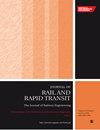Analysis of rail corrugation deterioration behavior on a heavy-haul railway
IF 2.1
4区 工程技术
Q3 ENGINEERING, CIVIL
Proceedings of the Institution of Mechanical Engineers Part F-Journal of Rail and Rapid Transit
Pub Date : 2024-06-21
DOI:10.1177/09544097241262360
引用次数: 0
Abstract
Rail corrugation is a common form of rail damage discovered when servicing heavy-haul railways that seriously affects the safety of wheel–rail systems. To determine the characteristics of the deterioration of a corrugated heavy-haul railway, this study used ABAQUS simulation software to establish a three-dimensional elastic–plastic wheel–rail finite element model. We then simulated the stress and strain distributions of wheel–rail contact spots as C80 freight cars pass through various corrugated sections of heavy-haul railways, featuring different wavelengths and wave depths. The simulation results demonstrated that the stress and strain increase from the peak positions to the troughs, reaching a maximum somewhere behind the troughs, and then decreasing to the next peak. The stress and strain increase as the depth of corrugation increases. The wheel–rail contact exhibits a maximum stress of 1.312 to 1.770 GPa, and the maximum strain is 0.6470% to 0.9897%. Wheel–rail contact stress and strain occur at a maximum of 8–40 mm after the troughs, rather than at the trough position, forming “planing and rolling” effects. This mechanism revealed by the variation in the stress and strain distributions in this study provides a reference for the in-depth analysis of rail corrugation deterioration and for the exploration of the mechanisms of corrugation deterioration of heavy-haul railways.重载铁路波纹劣化行为分析
钢轨波纹是重载铁路维修时发现的一种常见的钢轨损坏形式,严重影响轮轨系统的安全。为了确定波纹状重载铁路的劣化特征,本研究使用 ABAQUS 仿真软件建立了三维弹塑性轮轨有限元模型。然后,我们模拟了 C80 货车通过不同波长和波深的重载铁路波纹段时,轮轨接触点的应力和应变分布。模拟结果表明,应力和应变从波峰位置向波谷增加,在波谷后的某处达到最大值,然后减小到下一个波峰。应力和应变随着波纹深度的增加而增加。轮轨接触处的最大应力为 1.312 至 1.770 GPa,最大应变为 0.6470% 至 0.9897%。轮轨接触应力和应变的最大值出现在波谷后 8-40 mm 处,而不是波谷位置,形成了 "刨滚 "效应。本研究通过应力和应变分布的变化揭示了这一机理,为深入分析钢轨波纹劣化和探索重载铁路波纹劣化机理提供了参考。
本文章由计算机程序翻译,如有差异,请以英文原文为准。
求助全文
约1分钟内获得全文
求助全文
来源期刊

CiteScore
4.80
自引率
10.00%
发文量
91
审稿时长
7 months
期刊介绍:
The Journal of Rail and Rapid Transit is devoted to engineering in its widest interpretation applicable to rail and rapid transit. The Journal aims to promote sharing of technical knowledge, ideas and experience between engineers and researchers working in the railway field.
 求助内容:
求助内容: 应助结果提醒方式:
应助结果提醒方式:


